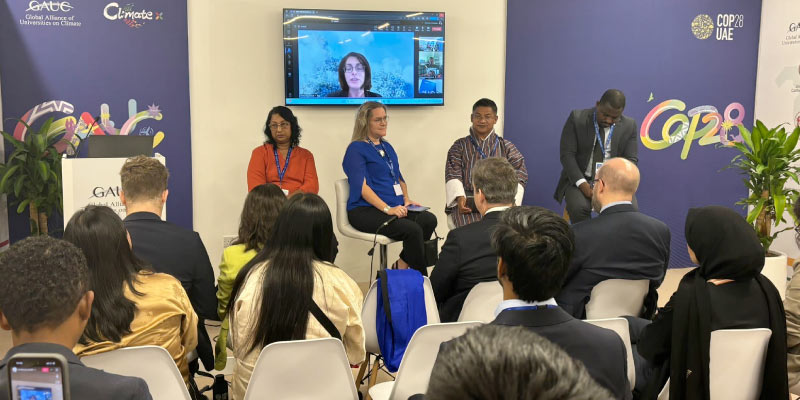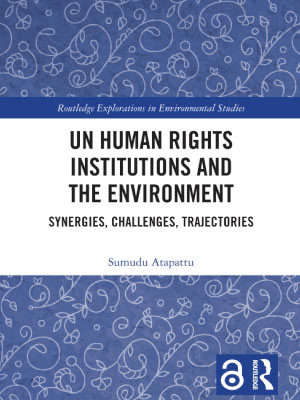
As issues like climate change, sustainable development, and depletion of natural resources become increasingly important topics to address, leaders, scholars, and lawyers worldwide are wondering how these environmental issues impact our human rights. UW–Madison faculty member and Nelson Institute affiliate Sumudu Atapattu, an expert on environmental law and human rights, dives into these issues in her new book, UN Human Rights Institutions and the Environment: Synergies, Challenges, Trajectories published by Routledge in 2023.

Atapattu completed her law degree in Sri Lanka, her home country, before completing a master’s degree in international law and a PhD in international environmental law, both at Cambridge University in England. She then became a law professor, teaching both at the University of Colombo in Sri Lanka, where she introduced environmental law into the curriculum, and at the UW. In addition to teaching at the UW Law School, Atapattu is the director of the Global Legal Studies Center, the executive director of UW–Madison’s Human Rights Program, and holds an affiliation with the Center for South Asia. She also is a four-time United Nations Climate Change Conference attendee, including COP21 where the Paris Agreement was adopted.
What first piqued your interest in environmental law?
I was pursuing my master’s degree at Cambridge shortly after the Chernobyl nuclear power plant accident and was wondering why nobody brought a claim against the USSR after heightened radiation levels were detected in the atmosphere. This was the first major environmental issue that was being discussed at an international level, and there was a lot of talk about how environmental issues should be addressed internationally. The field was relatively new at the time, so when I completed my PhD, I was one of the first people to specialize in international environmental law.
How are environmental law and human rights issues intertwined in Sri Lanka?
Although human rights law and environmental law issues were intertwined, the non-governmental organizations (NGOs) didn’t necessarily work with each other. The environmental NGOs in particular didn’t look at the overall impact environmental issues had on people. For example, there were national parks they wanted to protect, but didn’t pay attention to the people who depended on the forest. Overall, these NGOs were very siloed in their approach, when it would have been beneficial for them to work together with other groups.
Is this an issue that’s particular to Sri Lanka?
Since I’ve been working on human rights law and the environment for quite some time, I also see this siloed approach at the international level — people are only working in either environmental law or human rights law. When I attend conferences, people ask me if I’m an expert on human rights or the environment, and it makes me think, “Does it matter?”

What inspired you to write UN Human Rights Institutions and the Environment: Synergies, Challenges, Trajectories?
One day I was reading Australia’s Country Report on Human Rights Practices, which was issued by the UN Committee on Economic, Social, and Cultural Rights. The report had extensive comments related to climate change, even going to the extent of calling upon Australia to ban future coal power plants. I thought it was interesting how a human rights body was making comments about climate change. None of the UN human rights bodies’ mandate includes environmental protection, but they’re increasingly making pronouncements on climate change, sustainable development, pollution, and other environmental issues. I wanted to investigate whether there was any coherence between their principles and what different human rights bodies are saying. I originally wanted to write an article about this, but soon realized that there was enough material for an entire book.
Where can people find your book?
UN Human Rights Institutions and the Environment: Synergies, Challenges, Trajectories was published by Routledge, and the publisher was able to make it open-access. If you visit the Routledge website, you can read the entire book for free!
Where do you think environmental law and human rights law are headed?
A couple of years ago, the United Nations General Assembly recognized the right to a healthy environment. This effort was in the works for several years, and it took the international committee almost 75 years since the adoption of the Universal Declaration of Human Rights to recognize this right. I think this will be especially beneficial for marginalized groups, such as Indigenous people, who can use this as a tool to call upon states to provide a healthy environment for people. While the recognition is important, there’s still a lot of work to be done regarding defining what it means and how it can be used by lawyers and environmentalists proactively, not just reactively.
Meet Sumudu Attapatu during Earth Fest
Role of UN Human Rights institutions in Protecting Environmental Rights
Monday, April 22 | 4–6:30 p.m.
Learn more